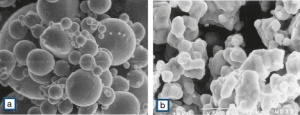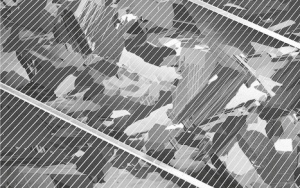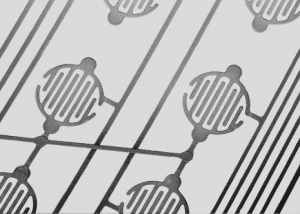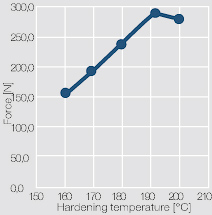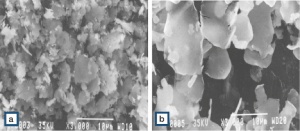Edelmetallpulver und -präparate
Contents
Edelmetallpulver
Edelmetallpulver kommen als Ausgangsprodukte für zahlreiche technische Anwendungen oder auch für medizinische und dekorative Zwecke zum Einsatz. Dazu zählen z.B. die Herstellung von Silber-Verbundwerkstoffen für elektrische Kontakte (Ag/Ni, Ag/Metalloxid, Ag/C, Ag/W u. a.), Katalysatoren, Elektroden oder Dentalprodukte. Darüber hinaus sind Edelmetalle in Pulverform Grundbestandteile für Präparate, Leitlacke und -klebstoffe.
Edelmetallpulver bestehen aus kleinen Partikeln von ca. 1 - 100 μm Durchmesser, die durch Kornform, -größe und -größenverteilung charakterisiert sind. Entsprechend dem gewählten Herstellungsverfahren weisen die Silber-Partikel eine unterschiedliche Morphologie auf, z.B. kugelig, kristallin oder dentritisch. Je kleiner der Partikeldurchmesser ist, um so größer ist die spezifische Oberfläche der Pulver.
Die scheinbare Dichte (Schütt- und Klopfdichte) der Pulver ist aufgrund der Zwischenräume zwischen den Partikeln niedrig, verglichen mit der Dichte erschmolzener Edelmetalle. Sie variiert in einem weiten Bereich von ca. 3 0,5 - 6 g/cm3, abhängig von der Morphologie der Partikel und ihrer Neigung zur Agglomeratbildung. Edelmetallpulver lassen sich pressen und sintern; ein gewisser Porenanteil bleibt jedoch erhalten.
Edelmetallpulver werden nach verschiedenen Verfahren, z.B. durch Elektrolyse,
Verdüsen aus der Schmelze, chemische Fällung oder durch Zementation mit
unedleren Metallen, hergestellt. Je nach Herstellungsverfahren weisen Silber-
Pulver unterschiedliche Eigenschaften auf (Table 1 und
Qualitätsmerkmale verschieden hergestellter Silber-Pulver). So erhält
man beim Verdüsen aus der Schmelze ein Pulver mit hoher Klopfdichte, das
sich aus kugeligen Partikeln zusammensetzt. Durch Elektrolyse von Silbersalzlösungen
entstehen im allgemeinen unregelmäßige, dentritische bis kristalline
Formen.
Bei chemischen Prozessen können sehr feine Pulver mit großen spezifischen
Oberflächen erzeugt werden. Figure 1 zeigt exemplarisch REM-Aufnahmen von
verdüstem Silber-Pulver mit kugeliger Kornform (a) und zementiertem Pulver aus
abgerundeten Kristallagglomeraten (b).
Powder type | GE | GN1 | ES | V |
|---|---|---|---|---|
Manufacturing Process | chemical | chemical | electrolytic | atomized |
Particle shape | agglomerated | agglomerated | dentritic | spherical |
Avg. particle diameter (median) [µm] | 10 - 15 | 20 - 40 | - | 32 - 60 |
Medium particle size (FSS - Fisher Sub Sieve Size) [µm] | - | - | 4.0 - 6.0 | - |
Tap density (DIN/ISO 3953) [g/cm3] | 0.7 - 1.1 | 2.0 - 2.5 | 2.0 - 3.0 | 4.0 - 6.7 |
Specific surface area (B.E.T.) [m2/g] | 0.5 - 0.9 | - | - | - |
Edelmetallpräparate
Während früher Glas, Porzellan und Keramik vor allem für dekorative Zwecke mit Gold oder Platin überzogen wurden, dienen Edelmetalle bereits seit Jahren in weit größerem Masse dazu, verschiedene nichtmetallische Werkstoffe, wie Keramik, Glas oder Kunststoff elektrisch leitend zu machen. Zur Aufbringung auf das Grundmaterial wird das Edelmetall in feinpulveriger Form in einem organischen Träger dispergiert, der Lackbindemittel und spezielle Lösungsmittel enthält. Solche Präparate können über Siebdruck, Tampondruck, Spritztechnik, Tauchen oder mit einem Pinsel aufgetragen werden.
Edelmetall-Einbrennpräparate
Die in flüssiger oder pastenartiger Form vorliegenden Einbrennpräparate haben in der Elektrotechnik und Elektronik, insbesondere in der Dickschichttechnik ein breites Anwendungsfeld gefunden Table 2. Als edelmetallhaltiger Füllstoff wird wegen seiner hohen elektrischen Leitfähigkeit meist Silber eingesetzt. Nach dem Einbrennen, das in oxidierender Atmosphäre bei Temperaturen zwischen 400°C bis 850°C erfolgt, entsteht eine festhaftende, hochleitende Schicht. Bei der Verarbeitung im Siebdruckverfahren können beliebige Leiterbahnen aufgebracht werden Figure 2. Auf diese Weise entstehen Strompfade mit guten elektrischen Eigenschaften und hoher Temperaturbeständigkeit.
Preparation | Substrate Material | Application by | Firing Temperature [°C] | Properties | Silver Content [wt%] |
|---|---|---|---|---|---|
Argonor N92 | glass, ceramics | paint brush, spray gun | 530 - 650 | Viscosity 500 – 1.000 mPa·s, good solderability | 65 |
Argonor | glass, ceramics | screen printing | 530 - 650 | Viscosity 10 – 15.000 mPa·s, good solderability | 65 |
Conductive Paints and Adhesives
Conductive paints are precious metal preparations in liquid or paste form. They contain the metal filler material, fine silver particles as conductive pigments mostly in flake form, a paint compound on artificial resin basis, and an organic solvent Table 3. The solvent evaporates during drying in air or by aging at slightly elevated temperatures. This allows the silver particles to connect metallically and form conductive paths Figure 3.
Conductive adhesives are used mostly for mechanical bonding with low thermal impact. As the adhesive components high-polymer organic substances such as epoxy resins and mixed polymers are mostly used. They are made electrically filler materials such as flake shaped silver powders (70 – 80 wt%). Silver based conductive adhesives are available as single or two component adhesive systems. Both types are hardening without the application of pressure.
| Preparation | Substrate Material |
Application by | Drying [°C] |
Properties | Usage Amount [g/100 cm2] |
Area Resistance [Ω/m2] |
|---|---|---|---|---|---|---|
| AROMAL 38 | glass, plastics | spraying, immersion, paint brush |
RT, 30 min 100°C |
hard well conducting Ag layer for broad applications |
0.5 - 2 | < 0.1 |
| AROMAL 50 | glass, wax, plastics | spraying, immersion, paint brush |
10 min RT |
very flat surface, especially for electrolytic build-up |
0.5 - 2 | < 0.2 |
| AROMAL 70T | plastics | tampon printing | 60 min RT |
hard and well conductive coating | < 0.1 | |
| AROMAL 141 | plastics, paper- based plastics |
screen printing | 45 min 120°C |
mechanically very strong coatings |
< 0.05 | |
| AROMAL 170 | plastics | screen printing | 30 min 100°C |
flexible layers, well suited for foil materials |
< 0.05 | |
| AROMAL K 5 A+B | metal, glass | dispenser, screen printing |
24h RT, 3h 80°C |
mechanically very strong bond connection as alternative to soldering |
< 0.1 | |
| AROMAL K 20 | metal, plastics, ceramics |
dispenser, screen printing |
15 min 150°C |
flexible bonds which help decrease thermal stresses |
< 0.1 | |
| DOSILAC | Silver conductive paints in spray cans; can be spray painted; properties similar to those of AUROMAL 50 | |||||
Conductive paints and adhesives have broad applications in electrical and electronic engineering. They are used for example for the contacting of film resistors, mounting of terminal wires, conducting electrostatic electricity, or contacting components at low temperatures.
The mechanical strength of the bond connections depends mostly on the selected hardening temperature Figure 4 .
Precious Metal Flakes
To obtain certain desired physical properties of preparations the dispersed precious metals in flat flake-like particles (generally called "flakes") are needed. These are produced by milling fine metal powders in the presence of milling additives or agents. The properties of these metal flakes, i.e. silver flakes (ability to disperse easily, flow characteristics, electrical conductivity) are strongly dependent on the particle shape and size as well as on the type of milling agents used. Figure 5 illustrates through SEM photos a type of rather fine silver flake (medium particle size 4 – 6 µm) (a) and another one with relatively large flat but thin flake shapes (particle size 8 – 11 µm) (b). Typical commercial silver flake types are listed with their respective properties in Table 4. Gold and platinum can also be produced as powder flakes. By volumes used they are however of lesser commercial importance.
| Type of Flake | F56 | B190 | ES4 |
|---|---|---|---|
| Main characteristics | Low tap density | Very fine | Pure, wide grain size distribution |
| Silver content [wt%] | > 99.0 | > 99.0 | > 99.7 |
| Med. Grain size [μm] Tap density | 3 - 8 | 4 - 6 | 9 - 13 |
| DIN/ISO 3953 [g/cm3] | 0.7 - 1.1 | 2.1 - 2.7 | 2.7 - 3.6 |
| Spec. Surface area B.E.T. [m2/g] | 0.7 - 1.1 | 0.3 - 0.7 |
